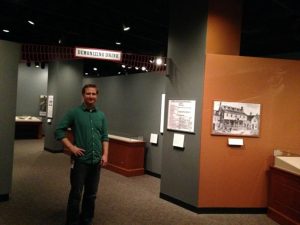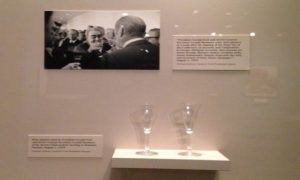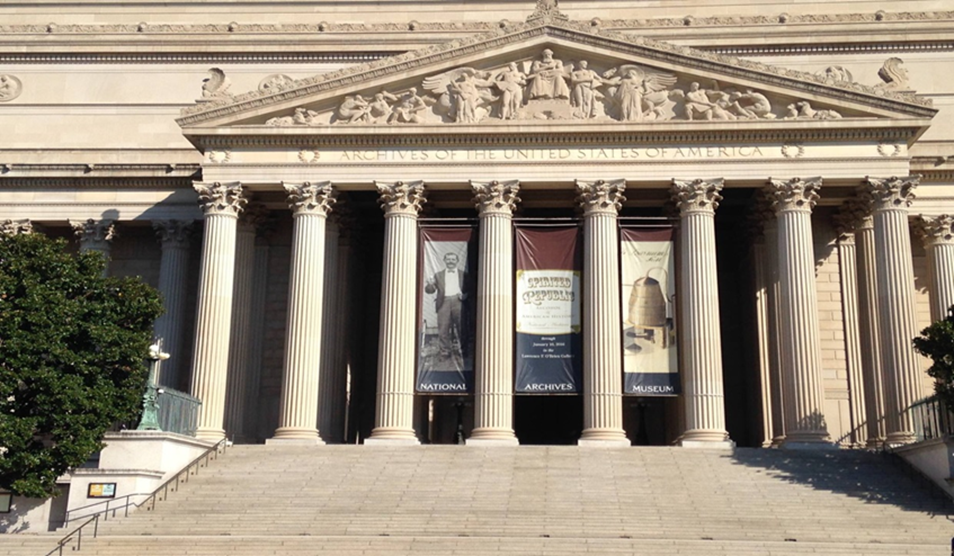The National Archives opened an exhibition earlier this year called “Spirited Republic: Alcohol in American History” in its Lawrence F. O’Brien Gallery of the National Archives MuseumNational Archives Museum in Washington, DC. Free and open to the public, this collection will be on display through January 10, 2016. The exhibit showcases the two different views of alcoholic beverages that run throughout American history, using “the National Archives documents and artifacts, about 100 original items, to reveal the evolution of the government’s alcohol policy over time, and to illustrate the wide variety of views about alcohol held by Americans. The stories they tell echo today’s debates over regulating drinking and the legalization of other drugs,” as stated on their website.

Patrick Kepley, Assistant Museum Registrar of the NARA in front of the Moral thermometer
The curators of the exhibit contacted the CAS Library in 2013 to borrow two images from our collection: Benjamin Rush’s Moral thermometer, first publicized widely in the Quarterly Journal of Studies on Alcohol, and the Crusade Scene. Although old images are often in the public domain, very few quality copies are available for use in books, let alone in an exhibit, where the picture is significantly enlarged. Our two images were digitally enhanced by former librarian Debbie Fanslow to meet the standards of this high-profile exhibit. Patrick Kepley, Assistant Museum Registrar of the National Archives and Records Administration, our contact person for this project, arranged a special visit, which included taking a few photos with permission.
Diverse materials displayed at the exhibit include documents and images of historical and sentimental value, such as The Moral Thermometer. Other objects range from memorabilia of those in recovery to the glasses Soviet Party Highness, Secretary Brezhniev, and President Ford used in the accompanying picture – a blast from the past for me. Also hidden in this photo is a reflection of Betty Ford’s life-size headshot. It reminded me of the Hazelden-Betty Ford programs and my upcoming visit, as well as the power of celebrities in recovery, who come forward, for example, by publishing their memoirs and providing therapeutic reading material.
Also hidden in this photo is a reflection of Betty Ford’s life-size headshot. It reminded me of the Hazelden-Betty Ford programs and my upcoming visit, as well as the power of celebrities in recovery, who come forward, for example, by publishing their memoirs and providing therapeutic reading material.
The exhibit targets various audiences and learning styles. Some visitors appreciate the beer posters or the 33 liquor labels proving the new interest in how to sell liquor right after the repeal.
In addition to landmark documents, highlights of the exhibition include President Franklin Delano Roosevelt’s cocktail shaker, a Betty Ford Center serenity prayer coin, and, of course, a first edition of The Big Book, another reminder how lucky we are at CAS to own some valuable items.
There was a small object displayed, which they called the predecessor of the modern breathalyzer, with its patent next to it. It looked very different from Greenberg’s Alcometer, another predecessor in the display cabinet of the Library. I discovered it about half way through, and it helped me identify what I was missing all day long: Jellinek, of course! I believe the Bunky Doodle should have been displayed there, as it belongs to the history of the Spirited Republic. However, among the audiovisual material from the NARA collection, I detected a few clips from a Raymond McCarthy educational film about responsible social drinking. All of the above reinforced that we are on the right track at CAS with our efforts to collect, preserve, and share our treasures, right in the footsteps of our predecessors at the Center.
Another remarkable feature in the room is the creative use of technology. The exhibit actually gave me further ideas and directions with our efforts to display our past, both on site and virtually. I doubt we will ever have the resources to create downloadable eCatalogs or eGuides for various devices and in various formats, but a virtual tour on the CAS web site does not seem too far-fetched.
The exit from the free exhibit leads the visitor through the Gift Shop, where they could not accommodate my request to take pictures of the central display, which featured artifacts and books related to the exhibit. Among the typical museum gift shop memorabilia, such as apparel, coasters, mugs, flasks, shot glasses, magnets, and cards, I was happy to discover scholarly books on alcohol history. Some authors and titles looked very familiar, such as the one pictured here, entitled Bootleg: murder, moonshine and the lawless years of Prohibition written by Karen Blumenthal, and available in the CAS Library collection. She and others did research in the CAS library in the past and we assisted them with their research. Many of them had the courtesy to give us proper credit, providing accidental PR for CAS.
 “Spirited Republic: Alcohol in American History”Spirited Republic: Alcohol in American History”: March 6, 2015—January 10, 2016, in the O’Brien Gallery. The National Archives Museum is located on the National Mall on Constitution Avenue at 9th Street, NW. Museum hours are 10 a.m. to 5:30 p.m. daily, except Thanksgiving and December 25.
“Spirited Republic: Alcohol in American History”Spirited Republic: Alcohol in American History”: March 6, 2015—January 10, 2016, in the O’Brien Gallery. The National Archives Museum is located on the National Mall on Constitution Avenue at 9th Street, NW. Museum hours are 10 a.m. to 5:30 p.m. daily, except Thanksgiving and December 25.
The Archives had a total of 1,221,528 visitors in 2015.
–Originally published in the November 2015 issue of the CAS Information Services Newsletter